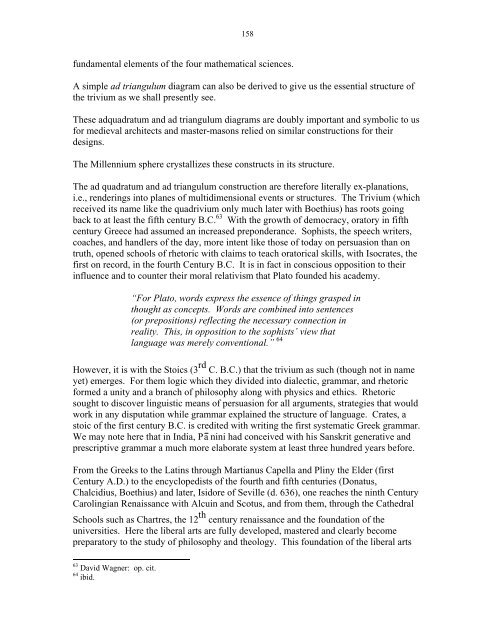Ad Quadratum Construction and Study of the Regular Polyhedra
Ad Quadratum Construction and Study of the Regular Polyhedra
Ad Quadratum Construction and Study of the Regular Polyhedra
You also want an ePaper? Increase the reach of your titles
YUMPU automatically turns print PDFs into web optimized ePapers that Google loves.
158<br />
fundamental elements <strong>of</strong> <strong>the</strong> four ma<strong>the</strong>matical sciences.<br />
A simple ad triangulum diagram can also be derived to give us <strong>the</strong> essential structure <strong>of</strong><br />
<strong>the</strong> trivium as we shall presently see.<br />
These adquadratum <strong>and</strong> ad triangulum diagrams are doubly important <strong>and</strong> symbolic to us<br />
for medieval architects <strong>and</strong> master-masons relied on similar constructions for <strong>the</strong>ir<br />
designs.<br />
The Millennium sphere crystallizes <strong>the</strong>se constructs in its structure.<br />
The ad quadratum <strong>and</strong> ad triangulum construction are <strong>the</strong>refore literally ex-planations,<br />
i.e., renderings into planes <strong>of</strong> multidimensional events or structures. The Trivium (which<br />
received its name like <strong>the</strong> quadrivium only much later with Boethius) has roots going<br />
back to at least <strong>the</strong> fifth century B.C. 63 With <strong>the</strong> growth <strong>of</strong> democracy, oratory in fifth<br />
century Greece had assumed an increased preponderance. Sophists, <strong>the</strong> speech writers,<br />
coaches, <strong>and</strong> h<strong>and</strong>lers <strong>of</strong> <strong>the</strong> day, more intent like those <strong>of</strong> today on persuasion than on<br />
truth, opened schools <strong>of</strong> rhetoric with claims to teach oratorical skills, with Isocrates, <strong>the</strong><br />
first on record, in <strong>the</strong> fourth Century B.C. It is in fact in conscious opposition to <strong>the</strong>ir<br />
influence <strong>and</strong> to counter <strong>the</strong>ir moral relativism that Plato founded his academy.<br />
“For Plato, words express <strong>the</strong> essence <strong>of</strong> things grasped in<br />
thought as concepts. Words are combined into sentences<br />
(or prepositions) reflecting <strong>the</strong> necessary connection in<br />
reality. This, in opposition to <strong>the</strong> sophists’ view that<br />
language was merely conventional.” 64<br />
However, it is with <strong>the</strong> Stoics (3 rd C. B.C.) that <strong>the</strong> trivium as such (though not in name<br />
yet) emerges. For <strong>the</strong>m logic which <strong>the</strong>y divided into dialectic, grammar, <strong>and</strong> rhetoric<br />
formed a unity <strong>and</strong> a branch <strong>of</strong> philosophy along with physics <strong>and</strong> ethics. Rhetoric<br />
sought to discover linguistic means <strong>of</strong> persuasion for all arguments, strategies that would<br />
work in any disputation while grammar explained <strong>the</strong> structure <strong>of</strong> language. Crates, a<br />
stoic <strong>of</strong> <strong>the</strong> first century B.C. is credited with writing <strong>the</strong> first systematic Greek grammar.<br />
We may note here that in India, Pa nini had conceived with his Sanskrit generative <strong>and</strong><br />
prescriptive grammar a much more elaborate system at least three hundred years before.<br />
From <strong>the</strong> Greeks to <strong>the</strong> Latins through Martianus Capella <strong>and</strong> Pliny <strong>the</strong> Elder (first<br />
Century A.D.) to <strong>the</strong> encyclopedists <strong>of</strong> <strong>the</strong> fourth <strong>and</strong> fifth centuries (Donatus,<br />
Chalcidius, Boethius) <strong>and</strong> later, Isidore <strong>of</strong> Seville (d. 636), one reaches <strong>the</strong> ninth Century<br />
Carolingian Renaissance with Alcuin <strong>and</strong> Scotus, <strong>and</strong> from <strong>the</strong>m, through <strong>the</strong> Ca<strong>the</strong>dral<br />
Schools such as Chartres, <strong>the</strong> 12 th century renaissance <strong>and</strong> <strong>the</strong> foundation <strong>of</strong> <strong>the</strong><br />
universities. Here <strong>the</strong> liberal arts are fully developed, mastered <strong>and</strong> clearly become<br />
preparatory to <strong>the</strong> study <strong>of</strong> philosophy <strong>and</strong> <strong>the</strong>ology. This foundation <strong>of</strong> <strong>the</strong> liberal arts<br />
63 David Wagner: op. cit.<br />
64 ibid.




